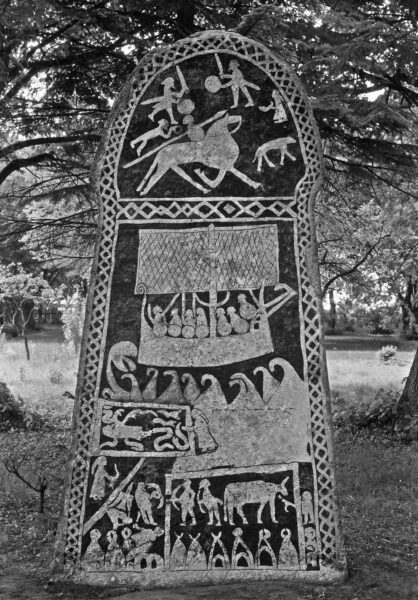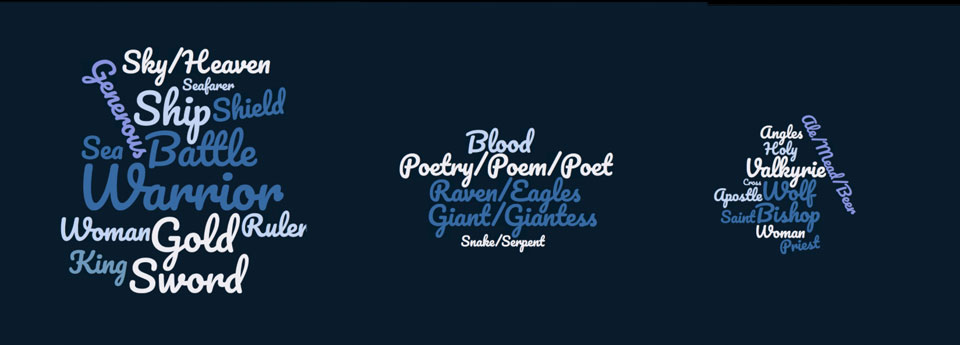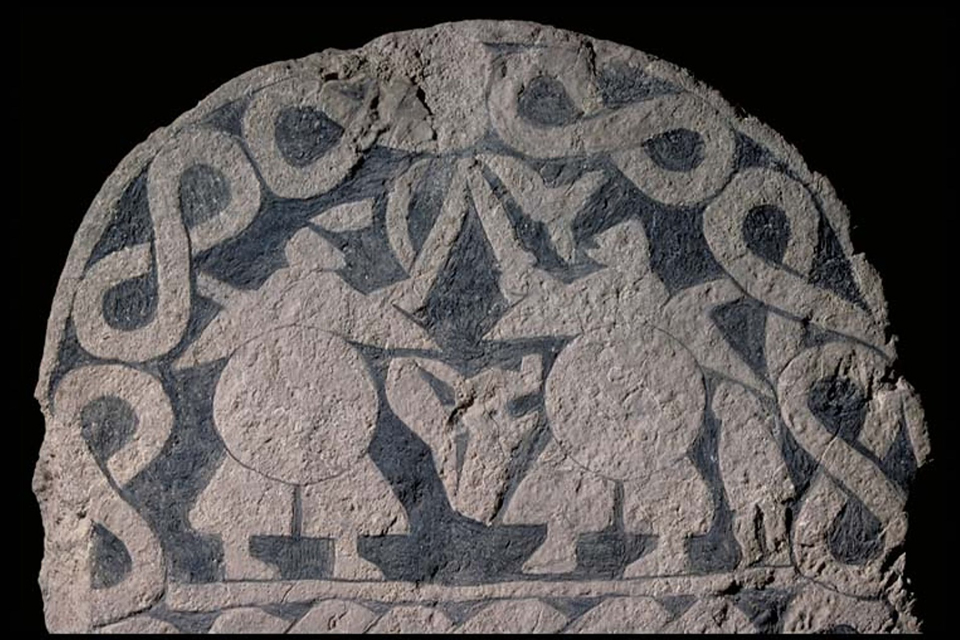Since 2002, the Skaldic project has published many of the Skaldic Verses from the Viking world. Although not complete, it offers us a preview of the main outline of the heroic world of the Vikings as depicted here.
The Skaldic Project has been editing the grand corpus of our medieval Norse-Icelandic skaldic poetry since 2002. With more than 853 poems and workgroups, and 164 prose works, the database offer up 5797 stanzas or verses. So far, 75% of the full corpus has been published by the 55 editors. The Skaldic project represents a vast and precious effort to make this world heritage available to us all.
Skaldic poetry was first created for and performed in the privileged milieu of the ruler, king or chieftain in the 9th century. Yet, we continue to find the complexities of the skaldic metre and its intricate diction both wondrous and amazing, as is the mythopoetic language used in the elaborate construction. Some scholars believe that Skaldic Poetry may even have functioned as a kind of secret or hermetic language known to the initiated in the royal and noble halls from Iceland to the Baltic. After the conversion to Christianity, the tradition of composing and performing poetry continued, now occasionally playing a religious and educational role. But in its heyday, in the 10th and 11th centuries, the Skaldic performance served primarily as a poetic soundboard for the ritualised grand feasts in the mead hall.
One of the characteristic elements of Skaldic poetry is the Kennings circumlocutions, where two nouns refer to a third, unspoken noun, the referent. Sometimes, whole sentences may be built out of such circumlocutions. With the kennings layered upon each other, such verses may have presented themselves as a kind of rebuses or riddles challenging the audience, somewhat like youngsters outdistancing their elders by solely communicating in emojis.
One of the more elaborate of these linguistic riddles stems from a verse by Þórðr Særeksson (Sjáreksson) from his poem, Þórálfs drápa Skólmssonar. This poet lived and worked at the beginning of the 11th century. In the poem, we hear the story of Þórálf inn Sterki. In one of the verses, we are told about how Þórálfr advances next to King Hákon Góði at the battle of Fitjar. The description tells us Þórálf is a mighty warrior. As such, he is described through a grand, elaborate and yet extremely convoluted so-called big kenning. It goes like this:
Nausta blakks hléman gifrs drífu gimsløngvir.
Reading the verse backwards, it literally may be translated as “fire-slinger of the storm of the troll-woman of the shielding moon of the horse of the boathouses”. The verse unpacks as follows:
- The horse of the boathouses means SHIP
- The shielding moon of the SHIP means SHIELD
- The troll-woman of the SHIELD means AXE
- The storm of the AXE means BATTLE
- The fire of the BATTLE means SWORD
- The slinger of the SWORD means WARRIOR.
According to the website, there are approximately 10.000 kennings in the corpus. Of these, 9237 from about 2995 verses have so far been painstakingly entered into a database. Most of these kennings, though, are much simpler than the “big kenning” quoted above.
The Word-Hoards
Any literary scholar fascinated by the beauty of the Old Norse language may well spend a lifetime unpacking these marvellous pieces of literature. Here, though, another more straightforward approach will be taken, in which we shall explore the “words” and “worlds” hidden behind the kennings.
After lumping the singular and plurals (like battle and battles) together, as well as words which are listed together (like ravens/eagles as well as singular ravens and eagles), we find there are 441 “words” in the Skaldic poems, subjected to being rewritten as kennings. Of these, two-thirds occur only 1 – 3 times, while a few – perhaps 7-10 %- attract most of the compound expressions.
With the numeral indicating the number of kennings each word attracts, the top scorers in three distinct word-hoards may be identified.

- Warrior 1112
- Battle 743
- Gold 543
- Ship 432
- Sword 397
- Generous 384
- Woman 331
- Sea 276
- Man 257
- Sky/Heaven 233
- Ruler 216
- Shield 250
- King 177
- Seafarer 176
- Raven/Eagle 167
- Giants/Giantesses 128
- Poems/Poetry/Poets 117
- Blood 107
- Poetry/Poem 89
- Snake/Serpent 81
- Bishop 43
- Wolf 47
- Valkyrie 35
- Holy Woman 22
- Ale/Mead/Beer 19
- Apostle 17
- Saint 17
- Priest 15
- Angles 14
- Cross 12

The result is clear: 85 % of the kennings registered in these three groups are attached to the first word-hoard and focus on the noble warriors and their heroic lifestyle. Only a miserly 4 % focus on the spiritual Netherworld and the individuals catering for the dead – whether Christian or Pagan. In between is the group of words referring to the dead left on the battlefield, while the carrion-cleavers or hræskuðr hover above, and the poets lament. This word-hord is referred to by 10 % of the kennings. It should be noted that apart from blood in this middle group, several very distinctive body parts are also listed. Each is only mentioned a few times (between four to ten), and while some of them – but not all – catalogue the wounds received in battle, they have been left out here. “Blood” stands pars pro toto for the corporeality of the dying warrior.
The first conclusion we may reach is the marked prevalence of the central topos, the living and breathing heroic world, as opposed to the afterlife. What matters in this genre is the preoccupation with life here and now, not what follows after the transcendence.
Caveat
The overall sparsity of these three word-hoards – compared to the number of kennings involved – obviously reflects the intention of the commentators, editors and literary scholars to reduce the complexity of the messages in the verses by “translating” the kennings to stock icons. The structural clarity may be a result of this endeavour. Nevertheless, the 441 words in the complete compendium indicate that more specific meanings were often enough intended by the poets; and also recognised by the editors and translators. At least for now, it seems safe to conclude that most of the circumlocutions, the kennings, do indeed refer to a strictly limited and clearly structured word-hoard, which falls neatly into the three carefully outlined worlds outlined here:
- the lived experience of the heroic warrior
- the warrior’s death on the battlefield and the rite des passage into a heroic fame fostered by the poet and his poetry
- the spiritual world of the afterlife served by either valkyries in Valhal or Christian priests or religious persons in Heaven.
Another challenge is posed by the long period in which the Skaldic poetry was created and performed. Due to the intricate metres, it is now generally believed that the earliest verses have been preserved intact. Hence, its is possible to outline at least two chronological layers, with the first covering the period from mythical times to c. 1035, and the second encompassing poems from c. 1035 to c. 1300. Perhaps, the balance between the three scenes – the Heroic world, the dying on the battlefield, and the afterlife would look differently, if the referents of the kennings were divided according to chronology. On the other hand, the number of valkyries (35) compared to bishops (43) – with the first one pointing to a pagan and the second to a christianised afterworld – is not that worrying.
Further work
Is this the whole story? Many details surface when we begin to study the patterns in this “heroic vocabulary”. For instance, God or Gods are only mentioned eight measly times, while bishops, priests and valkyries are recorded 93 times. On the other hand, Óðinn is widely mentioned in the poetry, though not as a kenning per se, but as a figure entering the scene in 130 different disguises. This tells us that the heroic world is not just outlined by the word hoards behind the kennings. Other items figure prominently, not least the God of the Skalds.
Another fascinating detail concerns the fascination with ships versus horses. The latter has only received five kennings, while the former – the ship – is poetically rendered in the form of kennings 432 times. Also, while swords and shields feature prominently, other weapons are treated to kennings only a few times; for instance, axes are rendered poetically 27 times, mail-shirts and -coats 17 times, arrows six times, and helmets only three times; swords, on the other hand, are mentioned 397 times and shields 253.
Finally, it might be noted that drinking – whether drinking horns, cups or ale, mead, and beer – is mentioned only sparingly. Acting, perhaps, as a correction to the perceived character of the communal feasting of the Vikings.
Such are some results of a cursory forage into the material. The result will look different when the full corpus has been published. Also, others may wish to wiggle the material in another way. Please feel free!
A special thanks is owed to Søren Sindbæk, who discovered the possibility of studying the structures of the referents behind the kennings in the material from the Skaldic Project and generously shared it on FB. (Any mistakes here, though, are my sole responsibility).
Karen Schousboe
SOURCE:
READ MORE:
…nú knáttu Óðin sjá: The Function of Hall-Based, Ritualised Performances of Old Norse Poetry in Pre-Christian Nordic Religion
By Simon Nygaard
In: The Fortified Viking Age. 36th interdisciplinary Symposium in odense, May 17th, 2017.
Published by: Research Center Centrum, Odense City Museums, University Press of Southern Denmark 2018
Hof, Halls, Goðar and Dwarves: An Examination of the Ritual Space in the Pagan Icelandic Hall.
By Terry Gunnel
In: Cosmos 17: 3-36.
